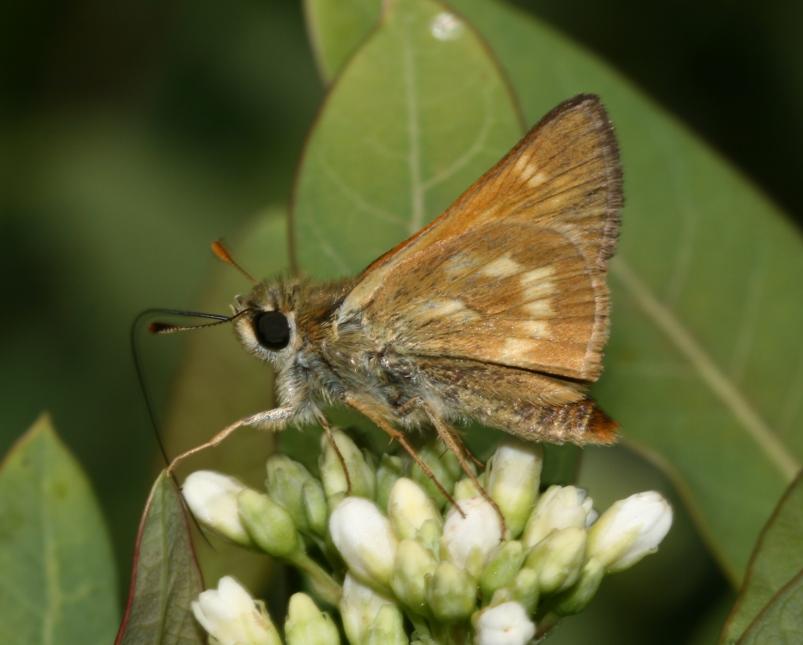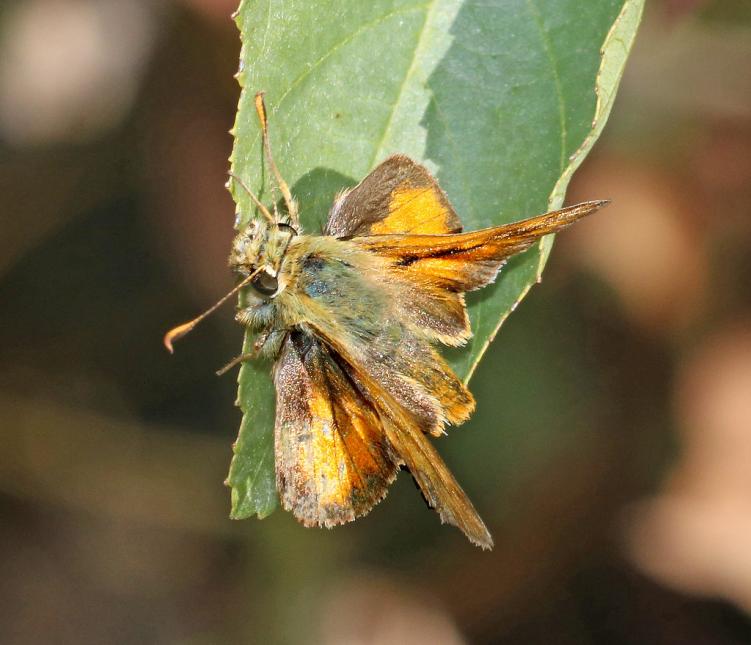Low-
Moderate
The population of the Dog Star skipper (a Sonora skipper subspecies) in Washington is critical and is considered to have a declining trend. This butterfly is recognized as "Species of Greatest Conservation Need" throughout its range due to the small number of isolated populations, specialized and restricted habitat, and known threats to its habitat. Research is needed to more accurately quantify specific habitat requirements including vegetation structure, food plant size and density, and key habitat features.
Description and Range
Physical description
Sonora skippers are small, tan butterflies; their wingspan is a slightly more than one inch. This butterfly has small, rectangular cells in a symmetrical semi-circular pattern enclosing a basal spot on the underside of its hind wing. The butterfly is difficult to identify and may be confused with the mardon skipper.
Ecology and life history
The Dog Star skipper inhabits glacial outwash prairies, forest glades, and road edges in southwest Washington lowlands. The hostplants (grass/sedge) for this species have not been identified, and habitat selection and suitability have not been studied. Hostplants feed caterpillars (larvae). Their primary nectar plants are unknown.
These skippers complete a single life cycle annually (univoltine). They are sedentary butterflies and do not migrate; instead, the species inhabits sites year-round (as egg, larva, pupa and adult), typically moving within only a few hundred meters of their natal locations.
Adults emerge from their chrysalids (pupae) during June through July. Males begin emergence first, followed by females; late-season individuals are primarily or solely females. Weather influences butterfly emergence and the flight period duration, with wet or cold conditions delaying emergence.
Both males and females feed by using their long proboscis to sip floral nectar.
Male skippers seek mates by perching on low vegetation and then darting out to inspect passing butterflies. Males that detect females commence courtship behavior; when males detect another male they engage in a territory defense behavior of tight, upward spiraling flight.
Females search for egg-laying sites by slowly flying and hovering just above hostplant vegetation and then depositing single eggs.
Skipper larvae conceal themselves in silken shelters and primarily feed at night. Sonora skippers are members of the Hesperiinae subfamily, whose larvae create shelters formed by webbing their hostplant grass blades together, and their prepupal larvae construct strong silken shelters in hostplant grasses in which pupation occurs. Sonora skippers overwinter as larvae.
Geographic range
Overall, the range of the Dog Star skipper is in southwest Washington; the butterfly occur in a few small, isolated populations. They inhabit glacial outwash prairies that have been reduced to less than three percent of historical cover. Occurrence has been documented in Grays Harbor, Mason, and Thurston counties.
Climate vulnerability
Sensitivity to climate change
Low-
Moderate
There is limited information on the sensitivity of the Sonora skipper to climate change. As an occupant of forest edges, prairies, meadows and other open sites, this species may exhibit sensitivity to fire, which can help maintain open habitat conditions. However, similar to other prairie butterflies, fire may cause adult and/or larval mortality. It likely exhibits some physiological sensitivity to climate conditions, as population numbers fluctuate yearly, but more information is needed.
Exposure to climate change
Low-
Moderate
- Altered fire regimes
Conservation
Conservation Threats and Actions Needed
- Invasive and other problematic species
- Threat: Invasive plants, those currently here, and many yet to come in the future, out-compete native grassland species and otherwise make habitat unsuitable
- Action Needed: Using herbicide, fire, and mechanical methods to restore native prairie
See the Climate vulnerability section above for more information about the threat posed by climate change to this species.
Resources
References
Crawford, R. and H. Hall. 1997. Changes in the south Puget Sound prairie landscape. Pp 11-15 in P. Dunn and K. Ewing (eds.) Ecology and Conservation of the south Puget Sound Prairie Landscape. The Nature Conservancy, Seattle, Washington . 289pp.
Hays, D., A. Potter, C. Thompson, and P. Dunn. 2000. Critical habitat components for four rare south Puget Sound butterflies. Final report to The Nature Conservancy. Washington Department of Fish and Wildlife. Olympia.
James, D. and D. Nunnallee. 2011. Life Histories of Cascadia Butterflies. Oregon State University Press, Corvallis. 447pp.
Pyle, R.M. and C.C. LaBar. 2018. Butterflies of the Pacific Northwest. Timber Press. 461 pp.
Pyle, R. 2002. The Butterflies of Cascadia. Seattle Audubon Society. Seattle, WA. 420 pp.
Pyle, R. 1989. Washington butterfly conservation status report and plan. Washington Department of Fish and Wildlife, Olympia. 216pp.
Schultz, C., E. Henry, A. Carleton, T. Hicks, R. Thomas, A. Potter, M. Collins, M. Linders, C. Fimbel, S. Black, H. Anderson, G. Diehl, S. Hamman, R. Gilbert, J. Foster, D. Hays, D. Wilderman, R. Davenport, E. Steel, N. Page, P. Lilley, J. Heron, N. Kroeker, C. Webb, and B. Reader. 2011. Conservation of prairie-oak butterflies in Oregon, Washington, and British Columbia. Northwest Science 85: 361–388
Takaoka, S., and F. Swanson. 2008. Change in extent of meadows and shrub fields in the central western Cascade Range, Oregon. The Professional Geographer 60:527-540.

